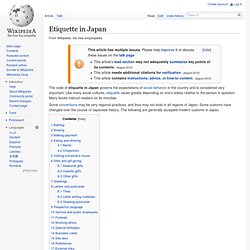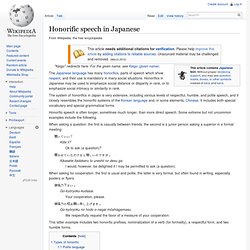

5629561197_e16a21573f. Tumblr_krogoa18pl1qzltr4o1_400. Lexfg3Exgz1qe8iyoo1_500. 1222759134748-custom. 18-sets-lot-New-Kimono-Baby-clothes-set-2-pcs-set-Baby-romper-Baby-garment-Free. Japan's Etiquette. As of July 1, 2013 ThinkQuest has been discontinued.

We would like to thank everyone for being a part of the ThinkQuest global community: Students - For your limitless creativity and innovation, which inspires us all. Teachers - For your passion in guiding students on their quest. Partners - For your unwavering support and evangelism. Parents - For supporting the use of technology not only as an instrument of learning, but as a means of creating knowledge. We encourage everyone to continue to “Think, Create and Collaborate,” unleashing the power of technology to teach, share, and inspire. Best wishes, The Oracle Education Foundation. Etiquette in Japan. The code of etiquette in Japan governs the expectations of social behavior in the country and is considered very important.

Like many social cultures, etiquette varies greatly depending on one's status relative to the person in question. Many books instruct readers on its minutiae. Bathing[edit] Bathing is an important part of the daily routine in Japan. Baths are for relaxing, and the body must be cleaned and scrubbed before entering the bathtub or furo. In homes with small tubs, each family member bathes one by one, in order of seniority, traditionally starting with the oldest male or the oldest person in the household (grandmother may bathe before the father of the house).
Bathtubs are increasingly common in modern Japanese homes, but there are still many small and old apartments in cities that do not have bathtubs, so public bathhouses called sentō are common. 1901 image of a sentō Onsen (温泉) translate into an English word hot spring. Bowing[edit] Bowing (お辞儀, o-jigi?) Bentō[edit] Japanese name.
Japanese names (日本人の氏名, nihonjin no shimei?)

In modern times usually consist of a family name (surname), followed by a given name. "Middle names" are not generally used. Japanese names are usually written in kanji, which are characters of usually Chinese origin in Japanese pronunciation. The kanji for a name may have a variety of possible Japanese pronunciations, but parents might use hiragana or katakana when giving a birth name to their newborn child. Names written in hiragana or katakana are phonetic renderings, and so lack the visual meaning of names expressed in the logographic kanji. While family names follow relatively consistent rules, given names are much more diverse in pronunciation and character usage. Structure[edit] The majority of Japanese people have one surname and one given name with no middle name, except for the Japanese imperial family, whose members bear no surname. Historically, myōji, uji and sei had different meanings. Characters[edit] Honorific speech in Japanese.
The Japanese language has many honorifics, parts of speech which show respect, and their use is mandatory in many social situations.

Honorifics in Japanese may be used to emphasize social distance or disparity in rank, or to emphasize social intimacy or similarity in rank. The system of honorifics in Japan is very extensive, including various levels of respectful, humble, and polite speech, and it closely resembles the honorific systems of the Korean language and, in some elements, Chinese. It includes both special vocabulary and special grammatical forms. Honorific speech is often longer, sometimes much longer, than more direct speech.
Parasol. Kimono_r_large.